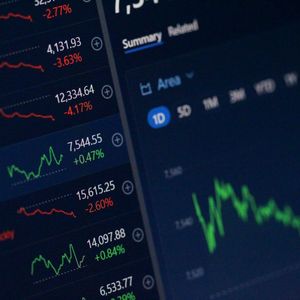Peter Schiff Issues Warning on USD Stablecoins, Favors Gold
6 min read
BitcoinWorld Peter Schiff Issues Warning on USD Stablecoins, Favors Gold Well-known economist and outspoken crypto skeptic, Peter Schiff , has once again stirred the pot in the cryptocurrency world, this time setting his sights on USD stablecoins . While Schiff is famously critical of Bitcoin and other cryptocurrencies, his recent comments highlight a specific concern regarding digital assets pegged to traditional fiat currency like the U.S. dollar. Peter Schiff’s Skepticism: Why Question USD Stablecoins? In a recent post on X (formerly Twitter), Peter Schiff , who serves as Chief Economist at Euro Pacific Asset Management, articulated his doubts about the fundamental value proposition of USD stablecoins . His core argument centers on the backing asset itself – the U.S. dollar. Schiff has long been a critic of government-issued fiat currencies, particularly the dollar, citing concerns about inflation, devaluation, and government debt. His skepticism towards USD stablecoins stems directly from this view. He questions why investors would opt for a digital asset whose stability is tied to a currency he believes is inherently flawed and subject to losing purchasing power over time. According to CoinDesk’s report on his comments, Schiff believes that choosing a digital asset pegged to a depreciating asset (in his view, the dollar) makes little sense when alternatives backed by what he considers a superior store of value, like gold, are available. Understanding Stablecoins: Beyond the Fiat Peg To appreciate Schiff’s perspective, it helps to understand what stablecoins are and how they function. At their heart, stablecoins are cryptocurrencies designed to minimize price volatility, unlike assets such as Bitcoin or Ethereum. They achieve this stability by pegging their market value to another, more stable asset. The most common type are fiat currency -backed stablecoins , where each digital token is supposedly backed by an equivalent reserve of traditional currency (like USD, EUR, etc.) held in a bank account. Examples include Tether (USDT) and USD Coin (USDC), which aim to maintain a 1:1 peg with the U.S. dollar. Other types of stablecoins exist: Crypto-backed stablecoins: Over-collateralized with other cryptocurrencies (e.g., Dai). Algorithmic stablecoins: Use complex algorithms and smart contracts to maintain price stability without direct asset backing (these have proven highly volatile and risky). Commodity-backed stablecoins: Pegged to assets like gold, oil, or real estate. Schiff’s focus is specifically on the first category, the USD stablecoins , which he sees as inheriting the weaknesses of the underlying fiat asset. The Allure of Gold-Backed Stablecoins Given his long-standing advocacy for gold as a reliable store of value, it’s unsurprising that Peter Schiff sees gold-backed stablecoins as a more sensible alternative. Unlike fiat, gold has a history spanning millennia as a medium of exchange and a store of wealth, largely independent of government policies. Gold-backed stablecoins aim to combine the stability associated with gold with the benefits of blockchain technology – ease of transfer, divisibility, and potential transparency (depending on the specific implementation and auditing). Each token in a gold-backed stablecoin system is typically claimed to represent a specific amount of physical gold held in secure vaults. Schiff himself acknowledged the existence of such offerings and, in response to a user suggestion, even stated his intention to potentially launch his own gold-backed stablecoin . This move would align his digital asset strategy with his core economic philosophy, offering investors a digital way to hold an asset tied to physical gold rather than a fiat currency he distrusts. Benefits Highlighted by Gold Advocates: Store of Value: Gold is historically seen as preserving purchasing power over long periods, unlike inflationary fiat currencies. Hedge Against Inflation/Devaluation: Gold tends to perform well during times of economic uncertainty or currency devaluation. Tangible Backing: Represents ownership in a physical asset, not just a claim on fiat reserves. Accessibility: Offers a potentially easier and more divisible way to invest in gold compared to buying physical bars or coins. Challenges for Gold-Backed Stablecoins: Custody and Auditing: Ensuring the physical gold actually exists and is securely stored requires robust auditing and trust. Liquidity: May not be as liquid or widely accepted for transactions as major USD stablecoins . Fees: Storage, insurance, and management fees for the physical gold can impact the token’s value or incur costs. Regulatory Uncertainty: Like all cryptocurrencies, they face evolving regulatory landscapes. Fiat Currency: The Foundation Schiff Questions The heart of Peter Schiff’s critique lies in his fundamental distrust of modern fiat currency systems. Fiat money, like the U.S. dollar, is not backed by a physical commodity (like gold) but by the full faith and credit of the government that issues it. Its value is derived from government decree and public trust. Schiff and others in the Austrian economics tradition argue that central banks’ ability to print money and governments’ tendency to run deficits inevitably lead to inflation, eroding the purchasing power of fiat currency over time. This makes assets denominated in or pegged to fiat, like USD stablecoins , susceptible to the same devaluation. From this perspective, a stablecoin pegged to the U.S. dollar is only as stable as the dollar itself. If the dollar loses 10% of its value due to inflation, the USD stablecoin , maintaining its 1:1 peg, also effectively loses 10% of its purchasing power relative to goods and services. Navigating the Stablecoin Landscape: Insights for Investors Peter Schiff’s comments highlight a critical debate within the digital asset space: what makes a stable digital asset truly ‘stable’ or valuable in the long term? For investors, this raises important considerations: Actionable Insights: Understand the Backing: Don’t just see ‘stablecoin’; investigate what asset it is pegged to and how that peg is maintained (reserves, algorithms, etc.). Assess the Underlying Asset: Consider the stability and long-term prospects of the asset backing the stablecoin (Is it a fiat currency you trust? A commodity? Another crypto?). Evaluate Reserve Transparency and Audits: Especially for fiat or commodity-backed stablecoins, look for clear, regular, and independent audits of the reserves. Consider Your Goals: Are you using stablecoins for short-term trading liquidity (where USD stablecoins are dominant) or as a long-term store of value (where gold-backed stablecoins might appeal to those sharing Schiff’s view)? Diversification: As with any investment, don’t put all your eggs in one basket, whether it’s one type of stablecoin or just stablecoins in general. Stay Informed on Regulation: The regulatory environment for all types of stablecoins is rapidly evolving, which can impact their availability and stability. While USD stablecoins currently dominate the market due to their deep liquidity and ease of use within the crypto ecosystem, Schiff’s arguments serve as a reminder that their perceived stability is intrinsically linked to the health and future of the U.S. dollar itself. Alternatives like gold-backed stablecoins offer a different value proposition, appealing to those seeking digital exposure to assets historically viewed as hedges against fiat currency instability. Conclusion: The Ongoing Debate Over Digital Stability Peter Schiff’s skepticism towards USD stablecoins is a natural extension of his long-held views on fiat currency and the enduring value of gold. He challenges the fundamental premise of pegging a digital asset to a currency he sees as prone to devaluation, advocating instead for the stability offered by gold-backed stablecoins . This debate is crucial for the future of digital assets. While USD stablecoins currently serve vital functions in the crypto market, the discussion around alternative backing assets like gold highlights different philosophies on what constitutes true, long-term stability in a digital format. Investors must look beyond the ‘stable’ label and understand the underlying mechanics and assets that give a stablecoin its value, considering whether they trust the future of fiat currency or prefer assets with a longer history as a store of wealth. To learn more about the latest explore our article on key developments shaping stablecoins institutional adoption. This post Peter Schiff Issues Warning on USD Stablecoins, Favors Gold first appeared on BitcoinWorld and is written by Editorial Team

Source: Bitcoin World



